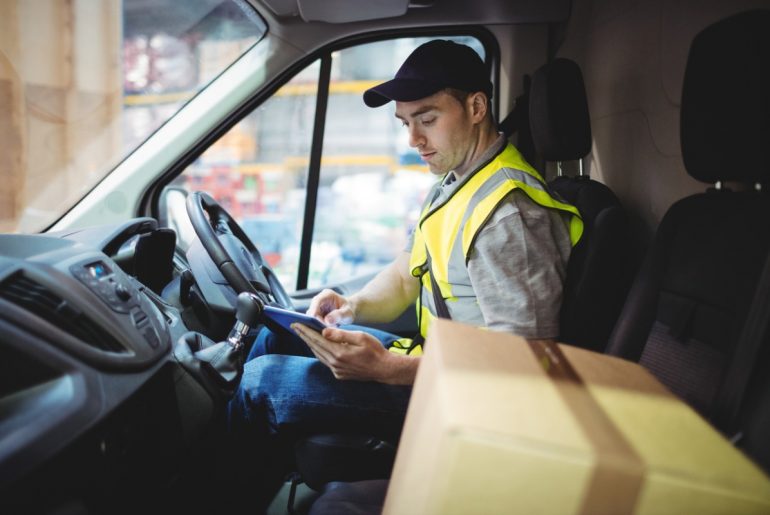The benefits of delivery driver training aren’t only for the drivers. Your customers, your community, and your company as a whole will be more satisfied when delivery drivers have a solid education in their work and the know-how to act on their feet.
Today, there is a shortage of professional, well-trained drivers in the industry due to the rise of the gig economy. Take that fact as a challenge well worth taking! An efficient, trained driver stands out from the crowd and draws the attention and business of more customers. We’d like to share our delivery driver training checklist in this article.
1. Customer Service Training
Customer service is the bedrock from which all successful companies build themselves. However, it can be difficult to define what excellent customer service looks like in the delivery industry.
Some delivery companies provide training in how to read dashboard navigation systems or how to properly load their vehicles–then stop there. That’s a critical error. Perhaps the most important skills for delivery drivers to learn are customer service, professionalism, and building relationships with customers.
Delivery drivers can lose sight of the importance of staying friendly, wearing a smile, and treating their jobs with integrity. Luckily, these skills are easy to train. Educate drivers about caring for packages as if they were their own. Impress the importance of a clean and hygienic workplace and uniform/dress. Finally, spend time getting expertise in speaking with customers professionally.
2. Become An Expert With In-House Delivery Software
Most delivery services have a preferred delivery management software for new drivers to use on day one. However, not all drivers are as technologically literate as others.
Any good delivery driver training checklist must give drivers adequate time to learn how to use navigation software. In a time when gig workers all have individual tastes in their chosen nav app, the benefits of managing all drivers and routes with a single software are huge.
Supervisors should take frequent rides with drivers and recruits to ensure the software is working correctly and efficiently. Going from point A to point B becomes much more complicated the minute you get on the road.
Set up all drivers with the same advanced mapping planner to simplify routes (especially multi-stop routes.) Make the learning curve less steep for recruits by giving in-person instructions, rather than in the classroom.
3. Safety Training
Personal and traffic safety training is the cornerstone of any delivery driver training plan. You won’t go far in the complicated, fast-paced world of deliveries without it. The first way to educate drivers on safety is to hire great employees.
The hiring process should give preference to calm, patient people. You might think that potential hires with a drive to work fast and under stress are the best, but the reverse is true. Screen for any past driving infractions, but also hire people who take their time and understand the value of “working smarter, not harder.”
Here are four delivery driver safety tips we’ve found useful in the past:
- Eliminate distracted driving opportunities. All drivers should sign off on an agreement to limit in-car distractions like music, radio, phone calls, or excessive speeds.
- Instruct on best practices for using a cell phone, eating in the car, cleaning the car, and maintaining car length distance in dense traffic.
- Highlight the importance of defensive driving. Some managers find success by installing GPS monitoring software in cars that can track aggressive driving. Others give training on defensive driving 101.
- Make on-road driving training a priority. At a minimum, drivers should know how to navigate in winter conditions, at night, and in areas without a data connection.
4. Order Loading And Unloading
It’s obvious that order loading and unloading is the key skill to master in the industry: in the name of the job, for one. But there’s a reason twenty-year veterans do it better than day-one recruits. Loading and unloading packages and precious cargo is an art.
The best way to train the art of order loading is by example. Select employees with proven experience to have ride-along with newbies to show them the ropes.
You’ll also want to give instructions on how to deliver packages in special circumstances. It’s rare when drivers have a workday without a problem popping up here or there. Train workers to deliver packages with care and how to leave them when recipients are absent, for example.
5. Learn How To Navigate Routes
Self-reliance is perhaps the law of successful delivery drivers. Mobile navigation apps have improved driver speed and efficiency, but all that goes out the door when GPS fails. How will your drivers adapt?
Good navigation skill training can make the difference between a good route and a disaster. And it doesn’t have to take much to unsettle even the most experienced drivers. Professional couriers should have a solid understanding of some of the following personal skills:
- Learn how to read street addresses the old way: by sight. Young drivers may not have developed a sense of how addresses work in the real world. Odd- and even-numbered streets are the first bit of knowledge to learn for yourself.
- Think three steps ahead of your current stop. Good couriers can imagine a mental picture of their route so no stop is a surprise. There’s a big difference between counting home addresses on the way to a relative’s house and being a pro.
- Use multiple navigation tactics. Google Maps is a great tool for many drivers, but if the server goes down, they’ll need to know how to read a map or jump onto a new app.
Conclusion
The delivery driver industry is growing and innovating every day as companies like Uber and Lyft rethink what delivery can be. However, companies need a solid delivery driver training checklist to ensure that drivers have the know-how and professionalism to work in any condition.
This list of delivery driver safety tips and training is just the tip of the iceberg. We hope you get a few ideas for how to improve your drivers’ workspace and habits so that customers truly notice their expertise. Above all, it’s invaluable to teach onboarded workers how to think on their feet, drive safely, and know their navigation routes like the back of their hand.




